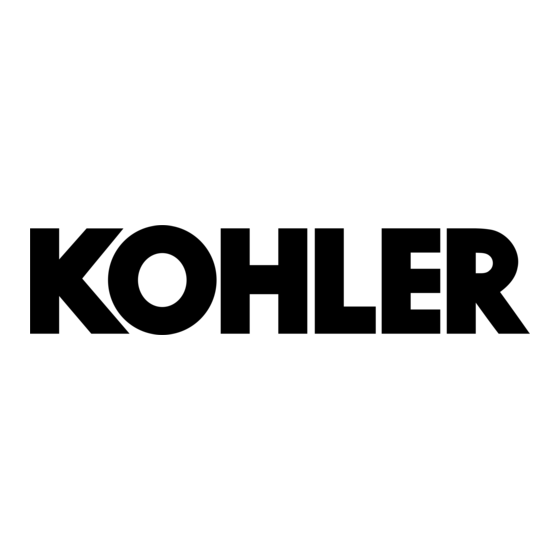Kohler 4EF Operatie - Pagina 26
Blader online of download pdf Operatie voor {categorie_naam} Kohler 4EF. Kohler 4EF 48 pagina's. Marine generator sets

3.7 Cooling System
3.7.1
Closed Heat Exchanger
In a closed cooling system, the seawater circulates
through separate chambers within the heat exchanger
to cool the engine water. The seawater then mixes with
engine exhaust and ejects out the exhaust outlet. See
Figure 3-4 for coolant capacity (include coolant
recovery tank capacity of 0.8 L (0.85 qts.).
Figure 3-5 for thermostat and pressure cap ratings.
Model
All models
Figure 3-4 Coolant Capacity
WARNING
Hot coolant and steam.
Can cause severe injury or death.
Before removing the pressure cap,
stop the generator set and allow it to
cool. Then loosen the pressure cap
to relieve pressure.
Checking the coolant level. Hot coolant can cause severe
injury or death. Allow the engine to cool. Release pressure
from the cooling system before removing the pressure cap. To
release pressure, cover the pressure cap with a thick cloth and
then slowly turn the cap counterclockwise to the first stop.
Remove the cap after pressure has been completely released
and the engine has cooled. Check the coolant level at the tank
if the generator set has a coolant recovery tank.
NOTICE
Saltwater damage. Saltwater quickly deteriorates metals.
Wipe up saltwater on and around the generator set and
remove salt deposits from metal surfaces.
Checking and Filling Coolant
Maintain the coolant level in coolant recovery tank at
approximately 1/4 full. Before filling the cooling system,
close all petcocks and tighten all hose clamps. Use a
solution of 50% ethylene glycol and 50% clean,
softened water to inhibit rust/corrosion and prevent
freezing. Add additional coolant, as necessary, to the
coolant recovery tank. Periodically check the coolant
level on closed systems by removing the pressure cap.
Do not rely solely on level in coolant recovery tank. Add
fresh coolant until the level is just below the overflow
tube opening.
14
Section 3 Scheduled Maintenance
See
L (Qts.)
2.84 (3.0)
Do not add coolant to a hot engine. Adding coolant to a
hot engine can cause the cylinder block or cylinder head
to crack. Wait until engine has cooled.
Note: Coolant solution. A coolant solution of 50%
ethylene glycol provides freezing protection to
--37°C (--34°F) and overheating protection to
129°C (265°F). A coolant solution with less than
50% ethylene glycol may not provide adequate
freezing and overheating protection. A coolant
solution with more than 50% ethylene glycol can
cause engine or component damage. Do not use
alcohol or methanol antifreeze or mix them with
the specified coolant.
manufacturer's operation manual for engine
coolant specifications.
Model
Pressure Cap Rating
Thermostat Rating
Figure 3-5 Pressure Cap and Thermostat Rating
Procedure for Flushing and Cleaning Cooling
System
For optimum protection drain, flush, and refill the cooling
system at the interval listed in the service schedule.
Pay special attention to the coolant level. After the
coolant drains, allow time for complete refill of the
engine water jacket.
described earlier.
1. Remove the hose clamp at the coolant hose. See
Section 1 for location of the hose.
2. Remove the pressure cap to make draining easier.
3. Drain, clean, and flush the coolant recovery tank.
4. Flush the system with clean water.
5. Replace the hose clamp to secure the coolant
hose.
6. Fill the system with the recommended coolant.
7. Replace the pressure cap.
3.7.2
Pressure Cap
Closed heat exchanger systems utilize a pressure cap
to raise the boiling point of the coolant, enabling higher
operating temperatures. If the cap leaks, replace it with
a cap of the same rating. Find the pressure cap rating in
Figure 3-5.
Consult the engine
5/7E
96.5 kPa (14 psi)
71_C (160_F)
Check the coolant level as
TP-5985 10/02
